Calculation Method for Decrease of Ship Speed in Actual Seas
CALCULATION METHOD FOR DECREASE OF SHIP SPEED IN ACTUAL SEAS
Overview
This section introduces the hybrid calculation method developed to accurately estimate the amount of ship speed reduction in waves and wind, a "10 mode index at sea."
Calculation of ship speed reduction
The amount of ship speed reduction is calculated by taking the difference between the ship's speed in still water and the ship's speed in wind and waves. Also, the total force exerted on a ship navigating in wind and waves is calcultaed by adding the wind resistance, the added resistance in waves, the resistance due to oblique motion and steering to the force in a calm sea.
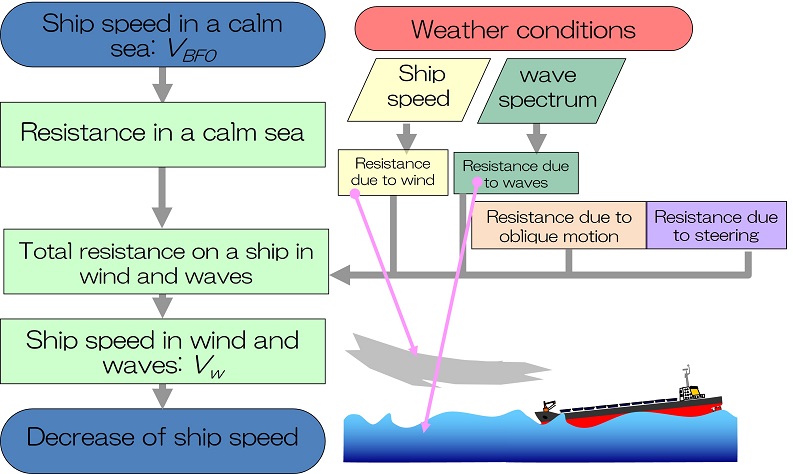
Flowchart for calculating ship speed reduction
Calculation of wind resistance
The wind resistance is calculated by an equation based on wind tunnel test results.
Accuracy has been verified by comparison with experimental values.
Click here for detailed calculation formulas→
 Wind Resistance Calculation Method
Wind Resistance Calculation Method
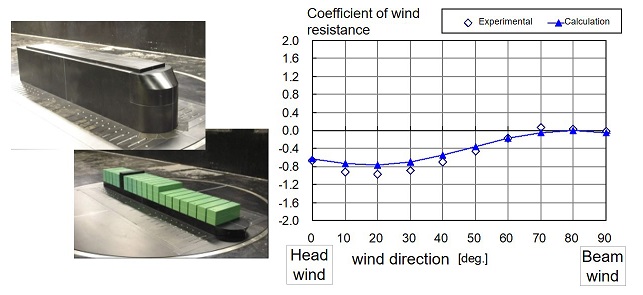
Comparison of wind tunnel test results and calculated values
Calculation of resistance due to waves
The resistance due to waves is determined by incorporating the results of simple tank tests into the calculation.
Waves in actual seas are a superposition of waves of various wavelengths and heights. To determine the resistance due to waves, the resistance due to regular waves with constant wavelength, wave height, and wave direction (addd resistance in regular waves) is determined, and then the resistance due to waves with various wavelengths and wave heights (added resistance in short crested irregular waves) based on the relationship between this resistance and wave height and the composition of irregular wave components organized by wavelength and wave direction (wave spectrum) is determined.
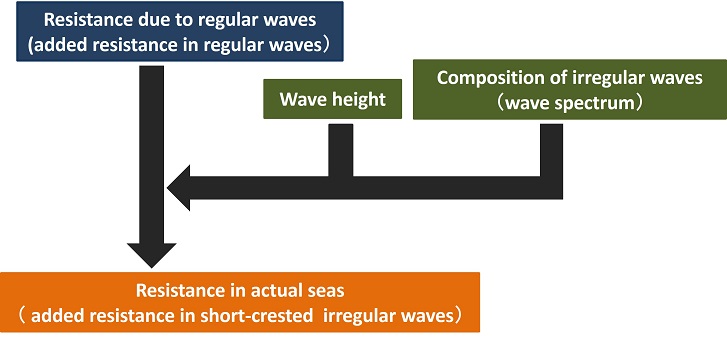
Flowchart for calculating resistance due to waves
In calculating the added resistance in regular waves, tank tests (10 mode test at sea) is carried out to incorporate shape effects above the water surface not considered in conventional methods and incorporate the results of these tests to improve calculation accuracy.
For more information on the "10 mode test at sea", click here. →
 10 Mode Test at Sea
10 Mode Test at Sea
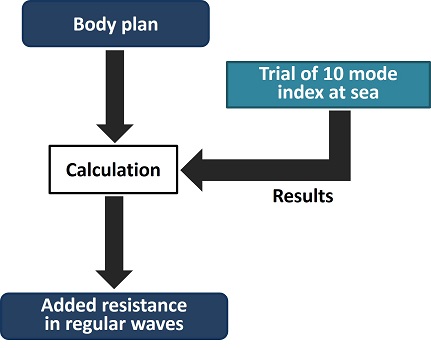
Flowchart for calculation of increased resistance in regular waves
Click here for detailed formulas for increased resistance in regular and short crest irregular waves.
→
 Calculation of Increased Resistance in Regular Waves
Calculation of Increased Resistance in Regular Waves
→
 Calculation of Increased Resistance in Short Crest Irregular Waves
Calculation of Increased Resistance in Short Crest Irregular Waves
Using these methods, the added resistance in regular waves and the added resistance in short crested irregular waves are calculated, and they are compared them with experimental values. The following figure shows the results for a container ship of 300 m in length and facing regular waves. It shows that the results agree well with the experimental data, regardless of the wavelength-to-shiplength ratio.
Click here for calculation results of the added resistance in regular waves and the added resistance in short crested irregular waves.
→
 Result of Calculation of Increased Resistance in Waves
Result of Calculation of Increased Resistance in Waves
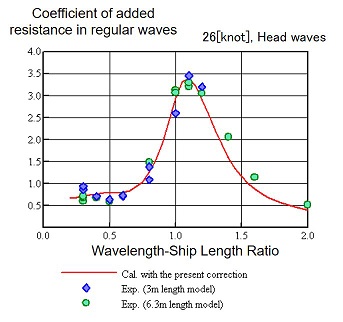
Added resistance in regular waves (300m container ship, Head waves)
Ship's speed in actual seas, amount of ship's speed reduction
The ship's speed in actual seasis obtained by numerically calculation of the vessel's speed balanced by the forces (wind resistance, wave resistance, oblique current force, and steering force) applied to the ship in actual seas. The reduction in ship speed is calculated by taking the difference between the ship's speed in actual seas and the ship's speed in a calm sea.
The figure below shows an example of ship speed calculation. When the sea conditions become rough, it shows that the ship's speed is remarkably reduced by wind and waves.
For detailed formulas for calculating a ship's speed and reduction in speed in actual sea conditions, click here→
 Calculation Method for Ship's Speed in Actual Sea Conditions
Calculation Method for Ship's Speed in Actual Sea Conditions
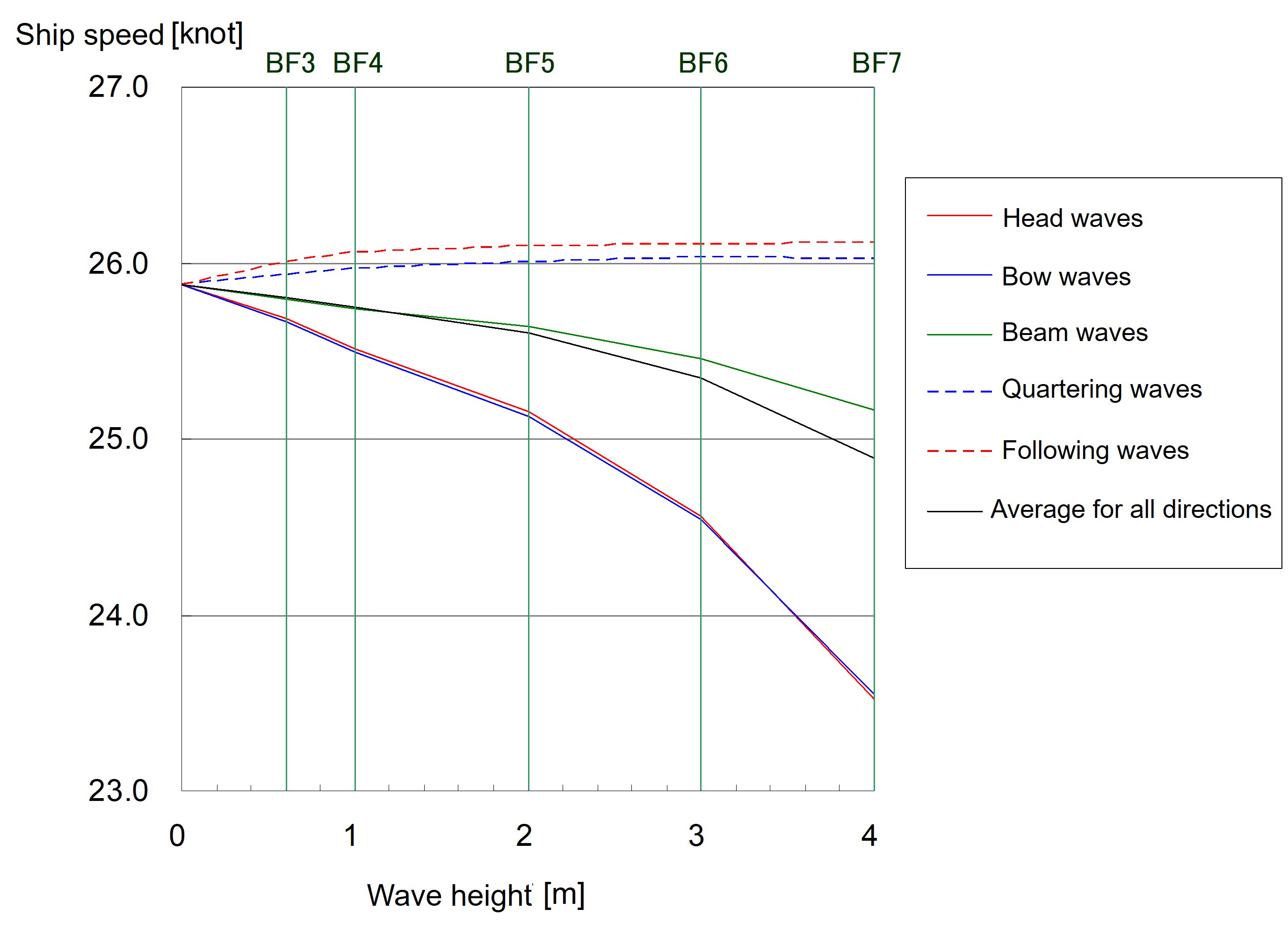
Example of ship speed calculation (300m container ship)
